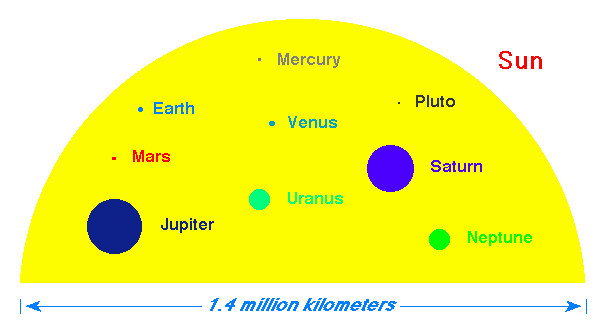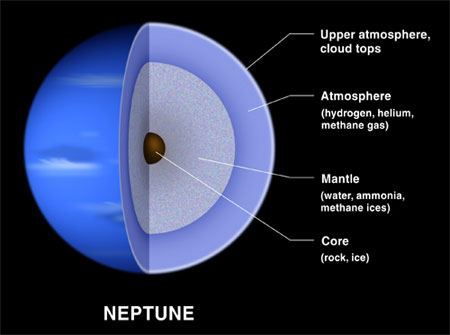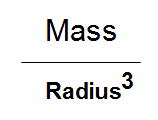











But note that 99.85% of the mass of the solar system is in the Sun. Below is a scaled drawing of all the diameters of the planets relative to the Sun.

Ambiguity: The distinction between a "Planet" and a "Moon" is fairly hazy as there are Moons which are bigger than some Planets. The discovery of large objects in the Kuiper belt in the last two years have added to this problem, making it currently unclear if we have 8,9,10,11 or 12 planets in the solar system. However, if a lesser body is in orbit about a bigger body, that lesser body will always be termed a "Moon".
The demotion of Pluto from a Planet to a non-planet is not a scientific issue whatsoever - its only a cultural issue.
Rather than dealing with classification names (e.g. moon or planet) its better to stick to physical defitions. Therefore, we will define solar system bodies in terms of their composition and geological properties. In these terms objects come in three categories:
You would think that students would easily be able to grasp
and understand and apply the concept of density but history/experience has shown otherwise.
Therefore we will spend some extra time on this subject.
To begin with, the density of planet refers to its bulk density. So even though the structure
of a planet, like Neptune below, might contain many different components of different density,
they all integrate together to produce the bulk density.

The bulk density of any object is its mass divided by the volume that it occupies.
For a sphere, the volume is 

But we only care about the r3 part. If you double the radius of a sphere, you increase its volume by 23 = 8.
So for any spherical object in the solar system its density goes as


The scaling is important here as we will compute all densities with respect to the density of the earth. We want to know how many more times or less times the density of an object is, compared to the Earth. This concept will definitely be tested on the midterm and the final - its fundamental to understanding the physical properties of objects.
So, for example:
If you want to compute the actual density then you would just multiply by the density of the Earth whic his 5.5 grams per cubic centimeter (g/cc).
Note that the density of water is 1.0 g/cc.
The reason that density is so important is that it provides an excellent diagnostic of whether or not an object is primarily made out of rocks, ices or gases.
If the density is less than 1.5 grams per cc then the object is almost exclusively made of frozen volatiles such as
If the density is greater than 3.0 grams per cc then the object is almost exclusively made of rocks. If the density exceeds about 5.0 grams per cc then there must be a large nickel-iron core in the interior of the object. For densities between 1.5 and 3.0 the object is a rocky-ice mixture.
Let's look at how the properties of the planets in the solar system correlate with distance from the Sun:
Planet Mass Radius Density Rotation #Moons
(earth=1) (earth=1) g/cc days
Mercury .05 .39 5.42 58d 0
Venus .81 .95 5.25 243d 0
Earth 1 1 5.54 1d 1
Mars .11 .53 3.94 1.02d 2
Jupiter 318 11 1.31 9.8h 15+
Saturn 95 9.5 0.70 10.2h 19+
Uranus 14.5 4.0 1.29 17.9h 9+
Neptune 17 3.9 1.64 19.1h 6+
Pluto .002 .18 2.03 6.4d 1
What can we notice here?
By our density definition we have 2 main groups of objects:
 Mars: These planets are
called the terrestrial planets (meaning rocklike). They are also
known as the inner planets.
Mars: These planets are
called the terrestrial planets (meaning rocklike). They are also
known as the inner planets.
 Pluto (and beyond): These planets are called the
Jovian planets (meaning gaslike). They are also known as the
outer plantes.
Pluto (and beyond): These planets are called the
Jovian planets (meaning gaslike). They are also known as the
outer plantes.

In addition to density, there are other important distinctions between the inner and the outer planets. These include:
These imply outer planets are big balls of gas, compressed by their own weight.
 they haven't been slowed down by tidal effects
they haven't been slowed down by tidal effects
Note: Pluto really doesn't belong, at all, in the same category as the outer planets as it shares none of their properties. Its an extremely small object that just happens to be in orbit about the Sun and hence is called a planet. In reality, Pluto is basically a large comet or perhaps more accurately, one of the larger objects in the collection of objects known as Kuiper Belt Objects. . The orbit of Pluto is also much more eccentric and inclined to the orbital plane than any of the other planets.
All of these distinctions are clues to how the overall solar system formed.